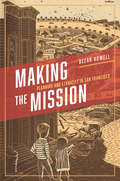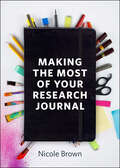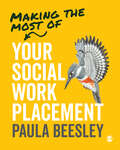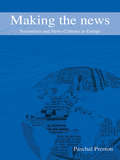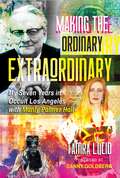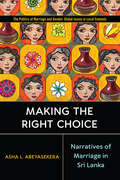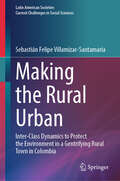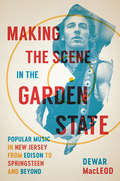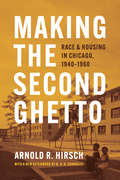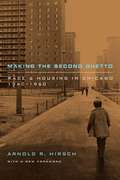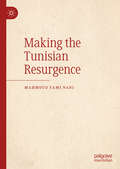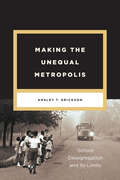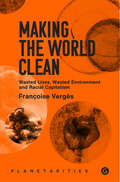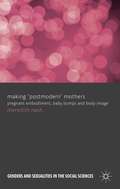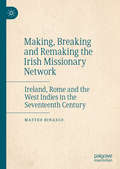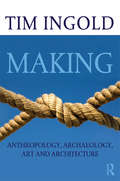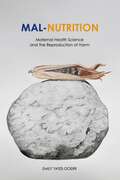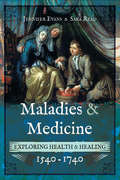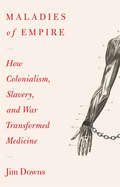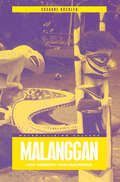- Table View
- List View
Making the Mission: Planning and Ethnicity in San Francisco
by Ocean HowellIn the aftermath of the 1906 San Francisco earthquake, residents of the city's iconic Mission District bucked the city-wide development plan, defiantly announcing that in their neighborhood, they would be calling the shots. Ever since, the Mission has become known as a city within a city, and a place where residents have, over the last century, organized and reorganized themselves to make the neighborhood in their own image. In Making the Mission, Ocean Howell tells the story of how residents of the Mission District organized to claim the right to plan their own neighborhood and how they mobilized a politics of place and ethnicity to create a strong, often racialized identity--a pattern that would repeat itself again and again throughout the twentieth century. Surveying the perspectives of formal and informal groups, city officials and district residents, local and federal agencies, Howell articulates how these actors worked with and against one another to establish the very ideas of the public and the public interest, as well as to negotiate and renegotiate what the neighborhood wanted. In the process, he shows that national narratives about how cities grow and change are fundamentally insufficient; everything is always shaped by local actors and concerns.
Making the Moral Case for Social Sciences: Stemming the Tide
by Karl SpracklenThe social sciences have a legitimacy problem in the modern world. The natural sciences are viewed as 'proper science' by journalists and policy-makers because they discover 'truths', make money, and help governments solve problems. In turn, defenders of the social sciences borrow the language of instrumentality, profit and policy impact. Karl Spracklen, by contrast, makes the moral case for the social sciences, arguing that they are a necessary social good capable of fighting inequality and revealing the workings of hegemonic power.
Making the Most of Your Research Journal
by Nicole BrownProviding practical guidance based on real-life examples, this book shows researchers different forms and ways of keeping a research journal and how to get the most out of journaling. Appealing to postgraduate students, new and experienced researchers, the book: • provides a theoretical grounding and information about knowledge and sensory systems and reflexivity; • presents a practical exploration of what a journal looks like and when and how to record entries; • includes helpful end-of-chapter exercises and online resources. Providing valuable food for thought and examples to experiment with, the book highlights the different forms of research journals and entries so that readers can find what works for them. Giving researchers licence to do things differently, the book encourages and enables readers to develop their own sense of researcher identity and voice.
Making the Most of Your Social Work Placement
by Paula Beesley'How can I succeed in my placement?' Your placement is a crucial part of your social work training - not only will a successful placement set you up to succeed in the rest of your degree, but it is also your chance to experience what real social work practice is like. This practical guide will takes you step by step through your social work placement, guiding you through what you will be expected to do, and helping you to make the most of your placement. You will learn how to apply the theory and skills you've learnt in practice, to your own observations as well as to your placement portfolio, and how to gain the feedback you need. The books is packed full of hands-on advice, alongside a variety of learning features: student voices talking about their own placement experiences, chapter checklists, reflective tasks, and potential placement pitfalls and opportunities which demonstrate different ways to approach situations you may encounter on placement.
Making the Most of Your Social Work Placement
by Paula BeesleyThis practical guide will takes you step by step through your social work placement, guiding you through what you will be expected to do, and helping you to make the most of your placement. You will learn how to apply the theory and skills you′ve learnt in practice, to your own observations as well as to your placement portfolio, and how to gain the feedback you need. The books is packed full of hands-on advice, alongside a variety of learning features: student voices talking about their own placement experiences, chapter checklists, reflective tasks, and potential placement pitfalls and opportunities which demonstrate different ways to approach situations you may encounter on placement.
Making the News: Journalism and News Cultures in Europe
by Paschal PrestonMaking the News provides a cross-national perspective on key features of journalism and news-making cultures and the changing media landscape in contemporary Europe. . Focusing on the key trends, practices and issues in contemporary journalism and news cultures, Paschal Preston maps the major contours of change as well as the broader industrial, organizational, institutional and cultural factors shaping journalism practices over the past two decades. Moving beyond the tendency to focus on journalism trends and newsmaking practices within a single country, Making the News draws on unique, cross-national research examining current journalism practices and related newsmaking cultures in eleven West, Central and East European countries, including in-depth interviews with almost 100 senior journalists and subsequent workshop discussions with other interest groups Making the News links reviews and discussions of the existing literature to original research engaging with the views and experiences of journalists working at the ‘coal face’ of contemporary newsmaking practices, to provide an original study and useful student text.
Making the Nonprofit Sector in the United States: A Reader
by David C. Hammack"It is a delight to seen an anthology on nonprofit history done so well."—Barry Karl, John F. Kennedy School of Government, Harvard University"This is a volume that everyone concerned about nonprofits—scholar, practitioner, and citizen—will find useful and illuminating."—Peter Dobkin Hall, Program on Non-Profit OrganizationsYale Divinity School"A remarkable book."—Robert Putnam, John F. Kennedy School of Government, Harvard University[One to come from John Simon, School of Law, Yale University by Jan. 13th and others are being solicited.] Unique among nations, America conducts almost all of its formally organized religious activity, and many cultural, arts, human service, educational, and research activities through private nonprofit organizations. Though partially funded by government, as well as by fees and donations, American nonprofits have pursued their missions with considerable independence. Many have amassed remarkable resources and acquired some of the most impressive hospital, university, performing arts, and museum facilities in the world. While some have amassed large endowments, many that surpass one billion dollars, there are also hundreds of thousands of small nonprofits, most with no tangible resources at all. How did the United States come to rely so heavily on nonprofits? Why has it continued to do so? What purposes do Americans seek to advance through nonprofits? How have Americans sought to control them? How have nonprofits been effected by the growth of government in the twentieth century? These questions suggest the complexity of the history of nonprofits in the United States. To help explore that history, this reader presents some of the classic documents in the development of the nonprofit sector along with important interpretations by recent scholars. The selections can be considered a representative part of a single extended conversation by the men and women who have taken part in the effort to define America and the American dream, even as they shaped what we now call the nonprofit sector. The statements by participants in the growth and development of the nonprofit sector are accompanied by essays written by historians and social scientists that provide concise surveys of important issues and periods. The essays give voice to those whose contributions to the American debate about voluntary associations and private institutions would otherwise be difficult to find or comprehend.The selections can be considered a representative part of a single extended conversation by the men and women who have taken part in the effort to define America and the American dream, even as they shaped what we now call the nonprofit sector. The statements by participants in the growth and development of the nonprofit sector are accompanied by essays written by historians and social scientists that provide concise surveys of important issues and periods. The essays give voice to those whose contributions to the American debate about voluntary associations and private institutions would otherwise be difficult to find or comprehend. Each selection has been chosen to define or illuminate important questions in the development of the nonprofit sector in the United States. Many include criticisms of particular nonprofit efforts, or of nonprofit activity in general. The intention is to provoke thought, not to establish an official list of readings. Though not every point of view could be included, the reader does reflect a general understanding of the nature of the nonprofit sector and its significance in the development of the United States. Philanthropic Studies—Dwight F. Burlingame and David C. Hammack, general editors
Making the Ordinary Extraordinary: My Seven Years in Occult Los Angeles with Manly Palmer Hall
by Tamra Lucid• Details how the author and her boyfriend developed a close friendship with Manly Hall and how Hall at first mistook her boyfriend as his heir apparent • Explains how Hall adopted the author as his &“girl Friday&” and personal weirdo screener, giving her access to the inner circles of occult Los Angeles • Richly depicts the characters who worked and gathered at Hall&’s Philosophical Research Society, including Hall&’s wife, the famed &“Mad Marie&” In the early 1980s, underground musicians Tamra Lucid and her boyfriend Ronnie Pontiac discovered the book The Secret Teachings of All Ages at the Bodhi Tree bookstore in Los Angeles. Poring over the tome, they were awakened to the esoteric and occult teachings of the world. Tamra and Ronnie were delighted to discover that the book&’s author, Manly Palmer Hall (1901-1990), master teacher of Hermetic mysteries and collector of all things mystical, lived in LA and gave lectures every Sunday at his mystery school, the Philosophical Research Society (PRS). After their first tantalizing Sunday lecture, Tamra and Ronnie soon started volunteering at the PRS, beginning a seven-year friendship with Manly P. Hall, who eventually officiated their wedding in his backyard. In this touching, hilarious, and ultimately tragic autobiographical account, Tamra shares an intimate portrait of Hall and the occult world of New Age Los Angeles, including encounters with astrologers, scholars, artists, spiritual seekers, and celebrities such as Jean Houston and Marianne Williamson. Tamra vividly describes how she used her time at the PRS to learn everything she could not only about metaphysics but also about the people who practice it. But when Tamra begs Hall to banish a certain man from the PRS--the same man who inherited Hall&’s estate and whom his wife Marie later alleged was Hall&’s murderer--Tamra and Ronnie are the ones banished. Tamra&’s noir chronicle of an improbable friendship between a twenty-something punk and an eighty-year-old metaphysical scholar reveals Hall not only as an inspiring esoteric thinker but also as a genuinely kind human being who simply wanted to share his quest for inner meaning and rare wisdom with the world.
Making the Right Choice: Narratives of Marriage in Sri Lanka (Politics of Marriage and Gender: Global Issues in Local Contexts)
by Asha L. AbeyasekeraMaking the Right Choice unravels the entangled relationship between marriage, morality, and the desire for modernity as it plays out in the context of middle-class status concerns and aspirations for upward social mobility within the Sinhala-Buddhist community in urban Sri Lanka. By focusing on individual life-histories spanning three generations, the book illuminates how narratives about a gendered self and narratives about modernity are mutually constituted and intrinsically tied to notions of agency. The book uncovers how "becoming modern" in urban Sri Lanka, rather than causing inter-generational conflict, is a collective aspiration realized through the efforts of bringing up educated and independent women capable of making "right" choices. The consequence of this collective investment is a feminist conundrum: agency does not denote the right to choose, but the duty to make the "right" choice; hence agency is experienced not as a sense of "freedom," but rather as a burden of responsibility.
Making the Rural Urban: Inter-Class Dynamics to Protect the Environment in a Gentrifying Rural Town in Colombia (Latin American Societies)
by Sebastián Felipe Villamizar-SantamaríaThis book takes the small rural town of La Calera, in the outskirts of the Colombian capital of Bogotá, as a case study to analyze how residents from different social classes – wealthier ex-urban newcomers arriving to traditionally peasant and rural areas – interact to decide how nature will be used in the face of further urban expansion. Contrary to the conflicts in other gentrification cases, including those of “green” gentrification, this book shows how newcomers and longtimers in La Calera use environmental concerns to bridge social class rifts and push the state to provide water, public space, and decision-making power. Residents see abundant ecological resources like water and land around them, but they do not have access to aqueducts, green public space or power over planning decisions affecting the distribution of these resources. As a response, and to challenge the state more effectively, newcomers and longtimers create inter-class alliances through what the author calls third nature: the way residents try to both protect and keep using existing ecological goods. To do so, despite high levels of class inequality, residents had a similar goal of protecting ecological resources around them by intervening in the physical and political landscapes against a state that induces scarcity, selectively enforcing environmental policies to the detriment of Calerunos. As cities all around the Global South continue to grow, urban expansion posits a threat to the environment by transforming agricultural and protected areas into denser residential or touristic spaces. Moreover, as natural resources become scarcer in the face of climate change, inequality might further existing environmental privileges and vulnerabilities. By examining closely how Calerunos bridge class inequalities for environmental reasons, this case highlights processes that inform other gentrifying rural spaces around the world.
Making the Scene
by Stuart HendersonMaking the Scene is a history of 1960s Yorkville, Toronto's countercultural mecca. It narrates the hip Village's development from its early coffee house days, when folksingers such as Neil Young and Joni Mitchell flocked to the scene, to its tumultuous, drug-fuelled final months. A flashpoint for hip youth, politicians, parents, and journalists alike, Yorkville was also a battleground over identity, territory, and power. Stuart Henderson explores how this neighbourhood came to be regarded as an alternative space both as a geographic area and as a symbol of hip Toronto in the cultural imagination.Through recently unearthed documents and underground press coverage, Henderson pays special attention to voices that typically aren't heard in the story of Yorkville - including those of women, working class youth, business owners, and municipal authorities. Through a local history, Making the Scene offers new, exciting ways to think about the phenomenon of counterculture and urban manifestations of a hip identity as they have emerged in cities across North America and beyond.
Making the Scene in the Garden State: Popular Music in New Jersey from Edison to Springsteen and Beyond
by Dewar MacLeodMaking the Scene in the Garden State explores New Jersey’s rich musical heritage through stories about the musicians, listeners and fans who came together to create sounds from across the American popular music spectrum. The book includes chapters on the beginnings of musical recording in Thomas Edison’s factories in West Orange; early recording and the invention of the Victrola at Victor Records’ Camden complex; Rudy Van Gelder’s recording studios (for Blue Note, Prestige, and other jazz labels) in Hackensack and Englewood Cliffs; Zacherley and the afterschool dance television show Disc-o-Teen, broadcast from Newark in the 1960s; Bruce Springsteen’s early years on the Jersey Shore at the Upstage Club in Asbury Park; and, the 1980s indie rock scene centered at Maxwell’s in Hoboken. Concluding with a foray into the thriving local music scenes of today, the book examines the sounds, sights and textures of the locales where New Jerseyans have gathered to rock, bop, and boogie.
Making the Second Ghetto: Race & Housing in Chicago, 1940–1960 (Historical Studies of Urban America)
by Arnold R. HirschFirst published in 1983 and praised by the likes of Ta-Nehisi Coates and Thomas Sugrue, Arnold R. Hirsch’s Making the Second Ghetto is the rare book that has only become more piercingly prescient over the years. Hirsch’s classic and groundbreaking work of urban history is a revelatory look at Chicago in the decades after the Great Depression, a period when the city dealt with its rapidly growing Black population not by working to abolish its stark segregation but by expanding and solidifying it. Even as the civil rights movement rose to prominence, Chicago exploited a variety of methods of segregation—including riots, redevelopment, and a host of new legal frameworks—that provided a national playbook for the emergence of a new kind of entrenched inequality. Hirsch’s chronicle of the strategies employed by ethnic, political, and business interests in reaction to the Great Migration of Southern Blacks in the mid-twentieth century makes startingly clear how the violent reactions of an emergent white population found common ground with policy makers to segregate first a city and then the nation. This enlarged edition of Making the Second Ghetto features a visionary afterword by historian N. D. B. Connolly, explaining why Hirsch’s book still crackles with “blistering relevance” for contemporary readers.
Making the Second Ghetto: Race and Housing in Chicago, 1940-1960
by Arnold R. HirschIn Making the Second Ghetto, Arnold Hirsch argues that in the post-depression years Chicago was a "pioneer in developing concepts and devices" for housing segregation. Hirsch shows that the legal framework for the national urban renewal effort was forged in the heat generated by the racial struggles waged on Chicago's South Side. His chronicle of the strategies used by ethnic, political, and business interests in reaction to the great migration of southern blacks in the 1940s describes how the violent reaction of an emergent "white" population combined with public policy to segregate the city. "In this excellent, intricate, and meticulously researched study, Hirsch exposes the social engineering of the post-war ghetto. "—Roma Barnes, Journal of American Studies "According to Arnold Hirsch, Chicago's postwar housing projects were a colossal exercise in moral deception. . . . [An] excellent study of public policy gone astray. "—Ron Grossman, Chicago Tribune "An informative and provocative account of critical aspects of the process in [Chicago]. . . . A good and useful book. "—Zane Miller, Reviews in American History "A valuable and important book. "—Allan Spear, Journal of American History
Making the Tunisian Resurgence
by Mahmoud Sami NabiThis book investigates the socioeconomic factors that triggered Tunisia’s "revolution for dignity” and the current issues and challenges facing its economy while suggesting mechanisms and instruments for their resolution. The author begins by analyzing the roots of the revolution and the post-revolution situation from a political sociology perspective and then diagnoses the Tunisian economy before and after the revolution and identifies the multidimensional binding constraints preventing it from escaping the middle-income trap. The book then explores the pillars of an inclusive development strategy that Tunisia should pursue. The emphasis is made on building inclusive institutions, developing a new social contract and reinventing the country's leadership. Beyond the institutional dimension, the author suggests innovative financial channels, discusses the strategy of a successful integration of the Tunisian economy in the global economy as well as the pillars of its transformation into a knowledge-based economy.
Making the Unequal Metropolis: School Desegregation and Its Limits (Historical Studies of Urban America)
by Ansley T. EricksonIn a radically unequal United States, schools are often key sites in which injustice grows. Ansley T. Erickson's Making the Unequal Metropolis presents a broad, detailed, and damning argument about the inextricable interrelatedness of school policies and the persistence of metropolitan-scale inequality. While many accounts of education in urban and metropolitan contexts describe schools as the victims of forces beyond their control, Erickson shows the many ways that schools have been intertwined with these forces and have in fact--via land-use decisions, curricula, and other tools--helped sustain inequality. Taking Nashville as her focus, Erickson uncovers the hidden policy choices that have until now been missing from popular and legal narratives of inequality. In her account, inequality emerges not only from individual racism and white communities' resistance to desegregation, but as the result of long-standing linkages between schooling, property markets, labor markets, and the pursuit of economic growth. By making visible the full scope of the forces invested in and reinforcing inequality, Erickson reveals the complex history of, and broad culpability for, ongoing struggles in our schools.
Making the University Matter (Shaping Inquiry in Culture, Communication and Media Studies)
by Barbie ZelizerMaking the University Matter investigates how academics situate themselves simultaneously in the university and the world and how doing so affects the viability of the university setting. The university stands at the intersection of two sets of interests, needing to be at one with the world while aspiring to stand apart from it. In an era that promises intensified political instability, growing administrative pressures, dwindling economic returns and questions about economic viability, lower enrolments and shrinking programs, can the university continue to matter into the future? And if so, in which way? What will help it survive as an honest broker? What are the mechanisms for ensuring its independent voice? Barbie Zelizer brings together some of the leading names in the field of media and communication studies from around the globe to consider a multiplicity of answers from across the curriculum on making the university matter, including critical scholarship, interdisciplinarity, curricular blends of the humanities and social sciences, practical training and policy work. The collection is introduced with an essay by the editor and each section has a brief introduction to contextualise the essays and highlight the issues they raise.
Making the World Clean: Wasted Lives, Wasted Environment, and Racial Capitalism (Goldsmiths Press / Planetarities)
by Francoise VergesAn antiracist theory of cleaning.In Making the World Clean: Wasted Lives, Wasted Environment, and Racial Capitalism, Françoise Vergès examines the racial and gendered politics of wasting lands, bodies, and resources and the organized deprivation of clean water, shelter, and access to health services—in other words, the structural denial, along racial lines, of vital needs. Through 38 short sections, she looks at the social relations that have made cleaning into drudgery and into a racialized, gendered, poorly paid job that is nevertheless necessary for any society to function. She concludes with the proposition of a feminist, decolonial, antiracist, anti-patriarchal, and anti-capitalist politics of cleaning. Or, simply put, of &“decolonial cleaning.&”To Vergès, the structural denial of the elemental needs of women of color (sanitary pads, access to water, and privacy for basic washing), and why these needs are considered insignificant and trivial, shows how racism and class war are gendered. By examining the banal, the trivial, and the elemental, the author addresses cleaning as a necessity rather than the maintenance of a consumerist lifestyle, a condition of basic care of the body and the mind that is considered with indifference by racial capitalism, white environmentalism, and even, too often, by humanitarian organizations. She argues that by building &“life-affirming institutions,&” as Ruth Wilson Gilmore advocates, struggles against the whitening of cleaning create sites of freedom. &“Decolonial cleaning&” imagines cleaning as taking care of land, humans, plants, animals, and rivers, not seeking to discipline them or transform them into commodities or objects of conservation but cleaning as a practice dedicated to sustaining the living world.
Making ‘Postmodern’ Mothers
by Meredith NashBased on interviews with pregnant women, this book provides a multi-disciplinary empirical account of pregnant embodiment and how it relates to wider sociological and feminist discourses about gender, bodies, 'fitness', 'fat', celebrity and motherhood.
Making, Breaking and Remaking the Irish Missionary Network: Ireland, Rome and the West Indies in the Seventeenth Century
by Matteo BinascoThis book reconstructs the efforts that were made to establish a missionary network between the two Irish Colleges of Rome, Ireland, and the West Indies during the seventeenth century. It analyses the process which brought the Irish clergy to establish two dedicated colleges in the epicenter of early modern Catholicism and to develop a series of missionary initiatives in the English islands of the West Indies. During a period of great political change in Ireland, continental Europe and the Atlantic region, the book traces how and through which key figures and institutions this clerical channel was established, while at the same time identifying the main obstacles to its development.
Making: Anthropology, Archaeology, Art and Architecture
by Tim IngoldMaking creates knowledge, builds environments and transforms lives. Anthropology, archaeology, art and architecture are all ways of making, and all are dedicated to exploring the conditions and potentials of human life. In this exciting book, Tim Ingold ties the four disciplines together in a way that has never been attempted before. In a radical departure from conventional studies that treat art and architecture as compendia of objects for analysis, Ingold proposes an anthropology and archaeology not of but with art and architecture. He advocates a way of thinking through making in which sentient practitioners and active materials continually answer to, or ‘correspond’, with one another in the generation of form. Making offers a series of profound reflections on what it means to create things, on materials and form, the meaning of design, landscape perception, animate life, personal knowledge and the work of the hand. It draws on examples and experiments ranging from prehistoric stone tool-making to the building of medieval cathedrals, from round mounds to monuments, from flying kites to winding string, from drawing to writing. The book will appeal to students and practitioners alike, with interests in social and cultural anthropology, archaeology, architecture, art and design, visual studies and material culture.
Mal-Nutrition: Maternal Health Science and the Reproduction of Harm
by Emily Yates-DoerrA free ebook version of this title is available through Luminos, University of California Press’s Open Access publishing program. Visit www.luminosoa.org to learn more.Mal-Nutrition documents how maternal health interventions in Guatemala are complicit in reproducing poverty. Policy makers speak about how a critical window of biological growth around the time of pregnancy—called the "first 1,000 days of life"—determines health and wealth across the life course. They argue that fetal development is the key to global development. In this thought-provoking and timely book, Emily Yates-Doerr shows that the control of mothering is a paradigmatic technique of American violence that serves to control the reproduction of privilege and power. She illustrates the efforts of Guatemalan scientists, midwives, and mothers to counter the harms of such mal-nutrition. Their powerful stories offer a window into a form of nutrition science and policy that encourages collective nourishment and fosters reproductive cycles in which women, children, and their entire communities can flourish.
Maladies & Medicine: Exploring Health & Healing, 1540–1740
by Jennifer Evans Sara ReadA lively account of medical practices in early modern England: &“Superb . . . an essential piece of social history.&” —Books Monthly It was an era when tooth cavities were thought to be caused by tiny worms and smallpox by an inflammation of the blood, and cures ranged from herbal potions, cooling cordials, blistering the skin, and of course letting blood. Maladies and Medicine tells the story of how the body was understood before the major advances of modern medicine, covering the theory of the four humors and the ways that male and female bodies were conceptualized. It also explains the hierarchy of healers, from university-trained physicians to the women who traveled the country offering cures based on inherited knowledge of homemade remedies, as well as the print explosion of medical health guides, which began to appear in the sixteenth century, from more academic medical textbooks to cheap almanacs. In twenty chapters discussing attitudes toward, and explanations of, some of the most common diseases and medical conditions of the period, the book reveals the ways people understood them and the steps they took to get better. It examines the body from head to toe, from migraines to gout. Case studies and personal anecdotes taken from doctors&’ notes, personal journals, diaries, letters, and even court records show the reactions of individuals to their illnesses and treatments, bringing us into close proximity with people who lived roughly four centuries ago. This richly illustrated study will fascinate those curious about the history of the body and the way our ancestors lived.
Maladies of Empire: How Colonialism, Slavery, and War Transformed Medicine
by Jim DownsA sweeping global history that looks beyond European urban centers to show how slavery, colonialism, and war propelled the development of modern medicine. Most stories of medical progress come with ready-made heroes. John Snow traced the origins of London’s 1854 cholera outbreak to a water pump, leading to the birth of epidemiology. Florence Nightingale’s contributions to the care of soldiers in the Crimean War revolutionized medical hygiene, transforming hospitals from crucibles of infection to sanctuaries of recuperation. Yet histories of individual innovators ignore many key sources of medical knowledge, especially when it comes to the science of infectious disease. Reexamining the foundations of modern medicine, Jim Downs shows that the study of infectious disease depended crucially on the unrecognized contributions of nonconsenting subjects—conscripted soldiers, enslaved people, and subjects of empire. Plantations, slave ships, and battlefields were the laboratories in which physicians came to understand the spread of disease. Military doctors learned about the importance of air quality by monitoring Africans confined to the bottom of slave ships. Statisticians charted cholera outbreaks by surveilling Muslims in British-dominated territories returning from their annual pilgrimage. The field hospitals of the Crimean War and the US Civil War were carefully observed experiments in disease transmission. The scientific knowledge derived from discarding and exploiting human life is now the basis of our ability to protect humanity from epidemics. Boldly argued and eye-opening, Maladies of Empire gives a full account of the true price of medical progress.
Malanggan: Art, Memory and Sacrifice (Materializing Culture)
by Susanne KüchlerShortlisted for the Katharine Briggs Folkore Award 2003 Malanggan are among the most treasured possessions in the Pacific, yet they continue to confound anthropologists. Central to funerals in New Ireland, these ‘death' figures are intended to decompose as symbolic representations of the dead. Wrapped in images that are conceived of as ‘skins', they are both visually complex and intriguing. This book is the first to interpret these mysterious agents of resemblance and connection as having a cognitive rather than a linguistic basis. Found in nearly every ethnographic museum in the world, Malanggan collections have been left virtually untouched. This original study begins by tracing the history of the collections and moves on to consider the role these artefacts play in sacrifice, ritual and exchange. What is the relationship between Malanggan and memory? How can Malanggan be understood as a life force as well as a vehicle for thought? In an analysis of the cognitive aspects of Malanggan, Küchler offers a highly original conceptualization of the centrality of the knot as a mode of being, thinking and binding in the Pacific. Malanggan: Art, Memory and Sacrifice is a groundbreaking study. Based on fifteen years of fieldwork and collection research, it provides an incisive new take on one of the Pacific's classic puzzles, as well as a wealth of new information and resources for anthropologists, collectors and curators alike.
